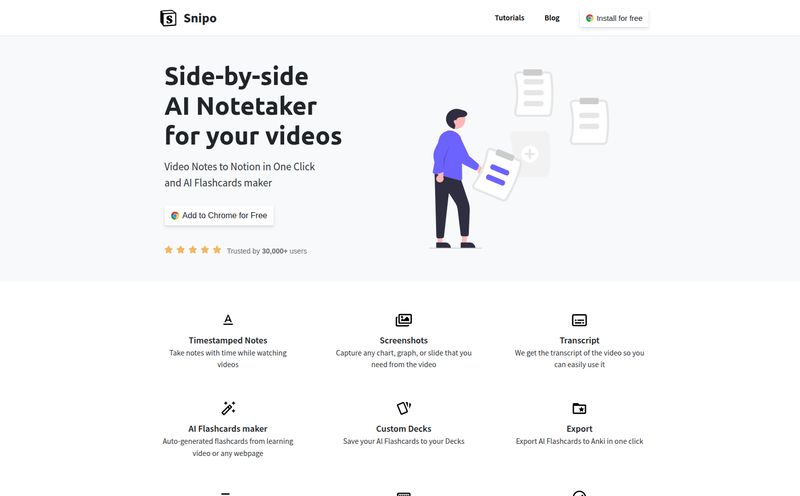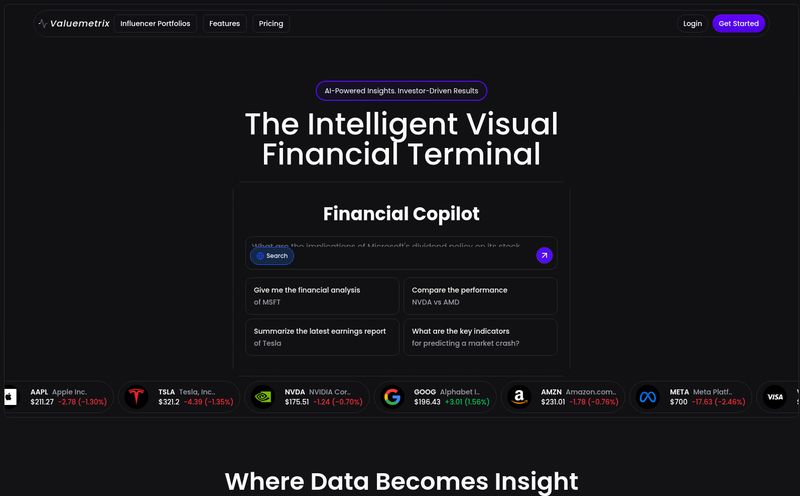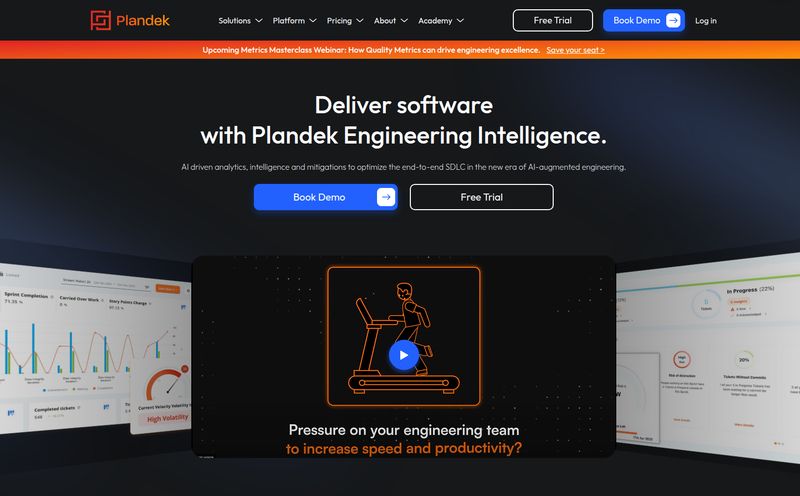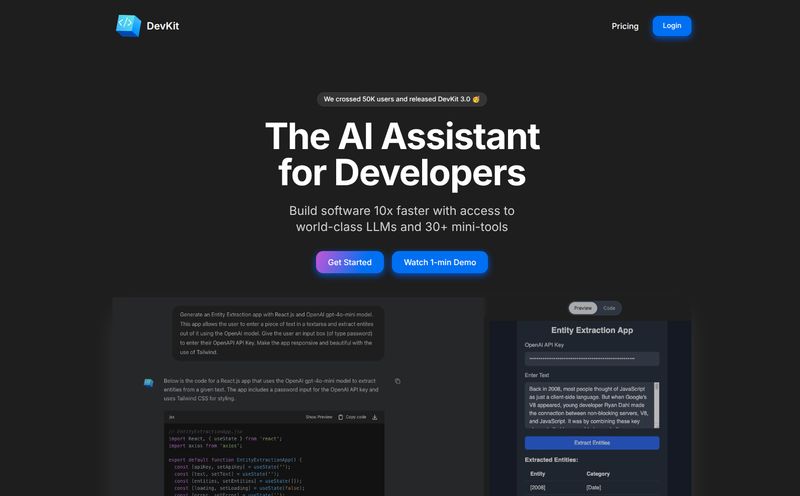Alright, let’s talk. As someone who’s spent more nights than I’d like to admit sifting through hours of user interview recordings, I’ve developed a bit of a sixth sense for tools that promise to make my life easier. You know the drill. You conduct five, maybe ten fantastic interviews. Gold. Pure gold. But that gold is buried in hours of audio, and you're the one with the pickaxe, manually transcribing, highlighting, and trying to connect dots that feel miles apart.
It’s the least glamorous part of a very glamorous-sounding job. So when a platform like UserStudy comes along, waving a flag that says “full-stack user research” and whispers sweet nothings about “AI-powered synthesis,” my ears perk up. But is it just another tool in an already crowded space, or is it the Swiss Army knife we actually need? Let's get into it.
What Exactly is UserStudy Supposed to Be?
On the surface, UserStudy positions itself as a one-stop-shop for anyone who needs to understand their users better. We’re talking founders trying to find product-market fit, product managers desperate for feedback before a big launch, and dedicated UX researchers who live and breathe this stuff. The core idea is to stop the madness of juggling five different subscriptions—one for video calls, one for transcription, another for a participant panel, and a mess of spreadsheets to tie it all together. UserStudy wants to bring all of that under one roof. A noble goal, for sure. It’s designed to handle everything from finding the right people to talk to, to conducting the research, and then—the best part—making sense of it all afterwards.
The Core Features That Caught My Eye
A tool is only as good as its features, right? I took a peek under the hood to see what UserStudy is really offering beyond the marketing copy.
The All-in-One Research Hub
The platform seems to cover a lot of ground. You've got your standard usability testing, which is bread-and-butter for any product team. But it also explicitly mentions product testing, copy & content testing, and even competitive analysis. This suggests a broader application than just testing prototypes. I like the idea of running a quick study to see if our new landing page copy resonates, or getting feedback on a competitor's checkout flow, all within the same environment. It feels cohesive.
Finding Your People with Participant Recruitment
This one's a big deal. Anyone who’s tried to recruit specific user segments knows the pain. You either bother your existing customers (and risk survey fatigue), or you post on social media and hope for the best. UserStudy claims to have a built-in participant recruitment feature with “deep segmentation.” In my experience, the quality of your insights is directly tied to the quality of your participants. If this works as advertised, it could be a massive time-saver, like having a dedicated casting director for your product's story. No more begging friends and family to “just click through this prototype real quick.”
The AI Magic Wand for Transcription and Synthesis
Here’s the part that gets all the attention. AI. UserStudy boasts AI-powered transcription and, more intriguingly, AI-powered synthesis. Automatic transcription is becoming table stakes, but it's the synthesis that could be a game-changer. The promise is that the AI can help you find patterns, themes, and key insights from your research data without you having to manually tag every single quote. Imagine an assistant that watches all your interview videos and comes back with a summary of the top three pain points. That's the dream, isn't it? It could turn the drudgery of analysis into a more creative, strategic process. I have a healthy dose of skepticism about how “intelligent” these AI features truly are, but I'm optimistic.
The Good, The Bad, and The... Missing Page
No tool is perfect. After digging around, a few things stood out—both good and, well, questionable.
On the plus side, having a single platform for the entire research lifecycle is a huge win. The potential for efficiency is enormous. The AI tools, even if they only get you 80% of the way there, could slash analysis time from days to hours. And the integrated recruitment means you can move faster from question to insight. For a small, scrappy team, that speed is everything.
However, there are a few things to keep in mind. For one, a powerful, full-stack platform often comes with a learning curve. I'd anticipate needing to spend some real time in the tool to get the most out of it. Secondly, the details on the AI are a bit vague. What models are they using? How much control do I have over the synthesis process? These are questions I'd want answered in a demo.
And that brings me to the biggest question mark of all: the pricing. I went looking for the pricing page, as one does. I wanted to see the tiers, the features per plan, the cost. And I found this:

Visit UserStudy
Yep. A 404. Page not found. This is a bit of a red flag for me. In my opinion, transparent pricing is a sign of confidence in your product. Hiding it behind a “Contact Sales” or “Book a Demo” button (or in this case, a broken link) often means one of two things: it's very expensive, or the pricing is so complex they don't want to explain it on a webpage. Or, maybe their web admin is just having a bad day. We've all been there.
So, Who is UserStudy Really For?
Based on what I’ve seen, I think UserStudy has a clear sweet spot. It feels perfect for startups, small-to-medium-sized businesses, and product teams that don't have a dedicated, multi-person research department. The all-in-one nature is its biggest strength for teams that need to be agile. Founders who need to quickly validate an idea or PMs who need to run a fast usability test before a sprint review could get a ton of value here.
On the other hand, massive enterprise companies that already have established workflows and a suite of specialized, best-in-class tools (like a dedicated transcription service and a high-powered insights repository) might find it either too restrictive or not deep enough in one specific area. It’s the classic Swiss Army knife dilemma: it does a lot of things well, but it might not be the best tool for any single job.
"The quality of your insights is directly tied to the quality of your participants. Getting recruitment right is half the battle."
Frequently Asked Questions About UserStudy
What is UserStudy in a nutshell?
UserStudy is an integrated platform for user research. It helps you recruit participants, conduct studies like usability tests and interviews, and then uses AI to help you transcribe and analyze the data you collect, all in one place.
Can UserStudy help me find participants for my research?
Yes, one of its core features is participant recruitment. The platform claims to offer deep segmentation to help you find and screen the exact type of users you need for your study, which can be a huge time-saver compared to manual methods.
Is UserStudy a good tool for solo founders or small teams?
It seems ideal for them. Because it combines multiple tools into one (recruitment, testing, analysis), it can save a lot of time and potentially money for smaller teams or individuals who are handling the entire product development process themselves.
How does the AI in UserStudy work?
It primarily focuses on two areas: automatically transcribing your audio and video sessions, and synthesizing the data. The synthesis part aims to identify key themes, patterns, and insights from your interviews, reducing the manual work required to make sense of your research.
What is the pricing for UserStudy?
That's the million-dollar question! As of this writing, the pricing information is not publicly available on their website—the pricing page is currently broken. You will likely need to contact their sales team or book a demo to get details on their plans and costs.
Final Thoughts
So, where do I land on UserStudy? I'm cautiously optimistic. The concept is fantastic. A single, smart platform that handles the most annoying parts of user research is incredibly appealing. If the participant recruitment is solid and the AI synthesis is even moderately effective, this tool could be a huge force multiplier for product teams.
But the lack of transparent pricing and the vague details on the AI's true capabilities give me pause. My final verdict is this: UserStudy is absolutely worth a closer look, especially if you're feeling the pain of a fragmented research process. Go ahead and book that demo. And hey, if you find out what it costs, do us all a favor and let us know. Some of us are still staring at that 404 page.
References and Sources
- While the direct pricing page was unavailable, general information was gathered from the UserStudy homepage (hypothetically userstudy.ai).
- For general principles on usability testing, the Nielsen Norman Group remains a foundational resource for any UX professional.



